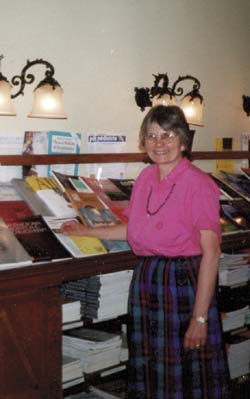|
Semmelweis Egyetem |
Semmelweis Egyetem újság |
2000/1. szám |
Előző cikk |
Következő cikk |
|
| Semmelweis Egyetem · I. évfolyam 1. szám · 2000. szeptember 15. |
|
From Somewhere Far Away to Semmelweis by Constance Putnam, PhD. |
The distance from the small town of Lyme, New Hampshire-in the part of the United States called „New England"-to the great city of Budapest is literally long. Figuratively it is also a very long way for a small-town doctor’s daughter to travel. But life holds surprises of many kinds. Today I no longer live in the town where I grew up, and Budapest is becoming a favorite destination for me after four visits. How did this come to pass? In particular, how is it that the most recent of those visits was made explicitly in search of Semmelweis? I am an American with no Hungarian foarebears. You could say that the closest I had been to Hungary before 1994 was the map of Czechoslovakia I drew for a school project, years ago. Not very close, in other words. Then there was the visit to the border the summer I studied in Vienna. But that was it. On the other hand, my interest in Ignac Semmelweis was kindled long ago by my father. A doctor with a keen sense of the important work done by his medical forebears, he loved to tell the tales of seminal moments in medical history. Thus from early childhood I knew the story of Semmelweis’s work in rough outline. The primary interest I shared with my father, however-and my mother, for that matter- was foreign languages. Dad had studied Greek (and Latin, of course) before taking up the study of medicine, as well as German. Mother studied Greek, Latin and Frech. In due course I followed suit by l arning all four of those languages, culminating in a summer spent in Vienna polishing my German. There I began to understand some of the history of the Austro-Hungarian Empire, and, for the first time, I turned my eyes to the East. I came to medical history much later, after a career in foreign language pedagogy. My first efforts in this new discipline resulted in papers on topics scattered across the centuries: Hippocratic medicine, lobar pneumonia, tuberculosis in the 19th century, the role of the doctors’s wife. Then I had an opportunity to co-author with the late Oliver Hayward the biography of an early American physician, Nathan Smith, whose practise area overlapped with Dad’s. I quickly realized that what might be called the „biography of medicine"-the way the lives of individual practitioners have influenced the history of medicine (and vice versa)-gripped my imagination and aroused my attention as nothing else had. Now all I needed was a new project. Ideally, I wanted another chance (like working on Nathan Smith) to bring my own past and my myriad interest into play. Visits to Hungary in 1994,1996 and 1999 proved key. Having fallen in love with country, and having collected a large number of Hungarian friends. I had also taken the first faltering steps toward learning the language. Echoes of the name „Semmelweis” reverberated in may mind, and I began to consider whether there might yet be some new insights into his life, career, and work to save the lives of birthing mothers that I could put before an English-speaking (and reading)audience. A very logical connection with my own New England heritage also emerged. A great classic of medical literature is a brief but brilliant essay on puerperal fever written by the Boston-based doctor Oliver Wendell Holmes. Interestingly enough, this was a few years before Semmelweis undertook his crucial statistical work on deaths in the obstetrical wards of Vienna’s Allgemeines Krankenhaus. An idea started to take shape for a cross-cultural comparison and contrast of two very differment men whose careers unfolded very differently but who shared a concern over childbed fever. Here at last I saw to take advantage – in a single medical-history project – of my perhaps somewhat sentimental attachment to my native region, my familiarity with Vienna, my growing affection for Budapest, and my love for travel. This also gives me a legitimate excuse for taking up the study of Hungarian in earnest-a mind – bending challenge in its own right. And so I have begun. I returned to Budapest in April 2000-and I shall do so again. |
